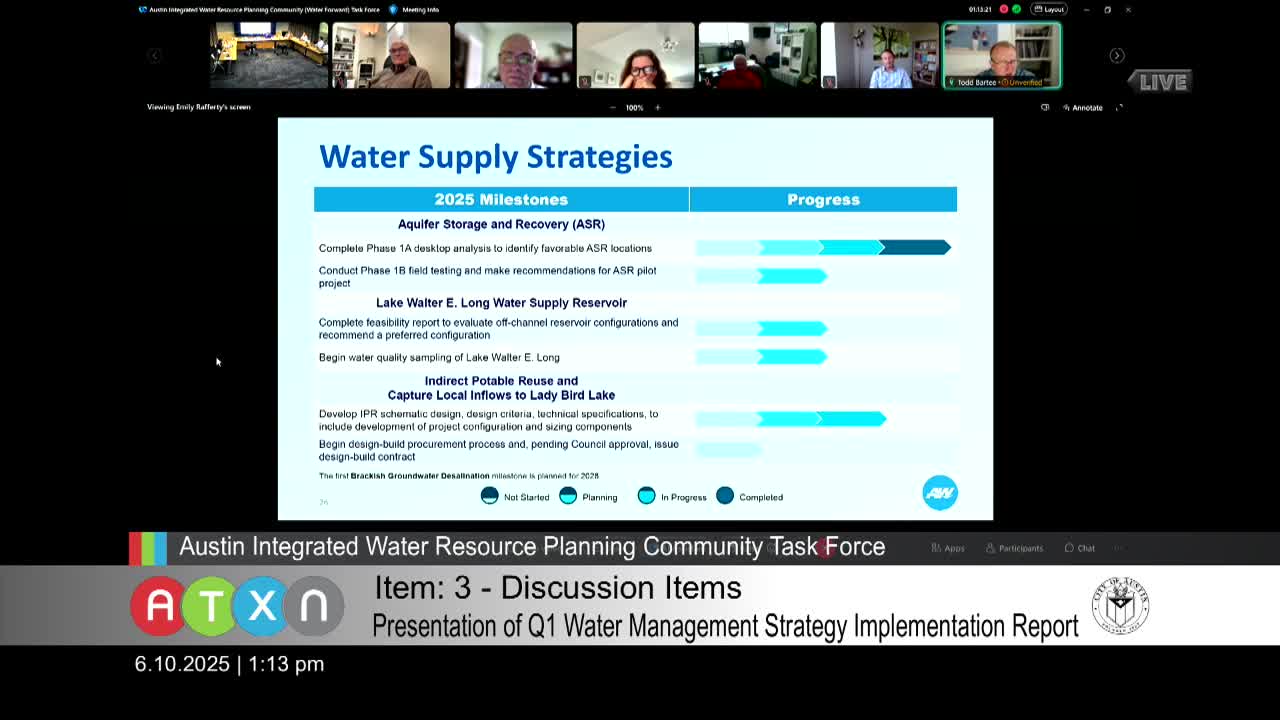Austin Water engages Bastrop County stakeholders on ASR project water supply strategies
June 10, 2025 | Austin, Travis County, Texas
This article was created by AI summarizing key points discussed. AI makes mistakes, so for full details and context, please refer to the video of the full meeting. Please report any errors so we can fix them. Report an error »

The Austin Integrated Water Resource Planning Community Task Force convened on June 10, 2025, to discuss critical water supply strategies and community engagement efforts related to the Aquifer Storage and Recovery (ASR) project. The meeting highlighted the importance of collaboration with external stakeholders and regulatory bodies to ensure the successful implementation of these strategies.
Marissa, a representative from Austin Water, outlined various water supply strategies under consideration, including indirect potable reuse through Ladybird Lake, brackish groundwater desalination, and the use of Lake Walter E. Long as a water supply reservoir. She emphasized that the indirect potable reuse strategy will require a permit from the Texas Commission on Environmental Quality (TCEQ) to discharge water into Ladybird Lake, along with plans for a new water treatment facility.
Concerns were raised about potential regulatory hurdles that could impede progress on the ASR project, particularly following legislative opposition. Task Force members expressed the need for proactive management of these challenges to avoid delays. In response, Austin Water has initiated discussions with stakeholders from Bastrop County, including local government representatives and advocacy organizations, to address community concerns and enhance transparency regarding the ASR project.
Austin Water is committed to engaging directly with the community rather than relying on external public relations firms. This approach aims to foster genuine relationships and ensure that local stakeholders are informed and involved in the decision-making process. The team has been meeting regularly with Bastrop County stakeholders since April 2025 and is working on a memorandum of understanding to outline commitments and collaborative efforts moving forward.
The Task Force acknowledged the importance of early and continuous engagement with the community, noting that lessons learned from the ASR project will inform future water supply initiatives. The discussions underscored the necessity of transparency and collaboration across multiple jurisdictions to secure Austin's water supply for the future. The next steps include finalizing the memorandum of understanding and continuing community outreach as the project progresses.
Marissa, a representative from Austin Water, outlined various water supply strategies under consideration, including indirect potable reuse through Ladybird Lake, brackish groundwater desalination, and the use of Lake Walter E. Long as a water supply reservoir. She emphasized that the indirect potable reuse strategy will require a permit from the Texas Commission on Environmental Quality (TCEQ) to discharge water into Ladybird Lake, along with plans for a new water treatment facility.
Concerns were raised about potential regulatory hurdles that could impede progress on the ASR project, particularly following legislative opposition. Task Force members expressed the need for proactive management of these challenges to avoid delays. In response, Austin Water has initiated discussions with stakeholders from Bastrop County, including local government representatives and advocacy organizations, to address community concerns and enhance transparency regarding the ASR project.
Austin Water is committed to engaging directly with the community rather than relying on external public relations firms. This approach aims to foster genuine relationships and ensure that local stakeholders are informed and involved in the decision-making process. The team has been meeting regularly with Bastrop County stakeholders since April 2025 and is working on a memorandum of understanding to outline commitments and collaborative efforts moving forward.
The Task Force acknowledged the importance of early and continuous engagement with the community, noting that lessons learned from the ASR project will inform future water supply initiatives. The discussions underscored the necessity of transparency and collaboration across multiple jurisdictions to secure Austin's water supply for the future. The next steps include finalizing the memorandum of understanding and continuing community outreach as the project progresses.
View full meeting
This article is based on a recent meeting—watch the full video and explore the complete transcript for deeper insights into the discussion.
View full meeting
